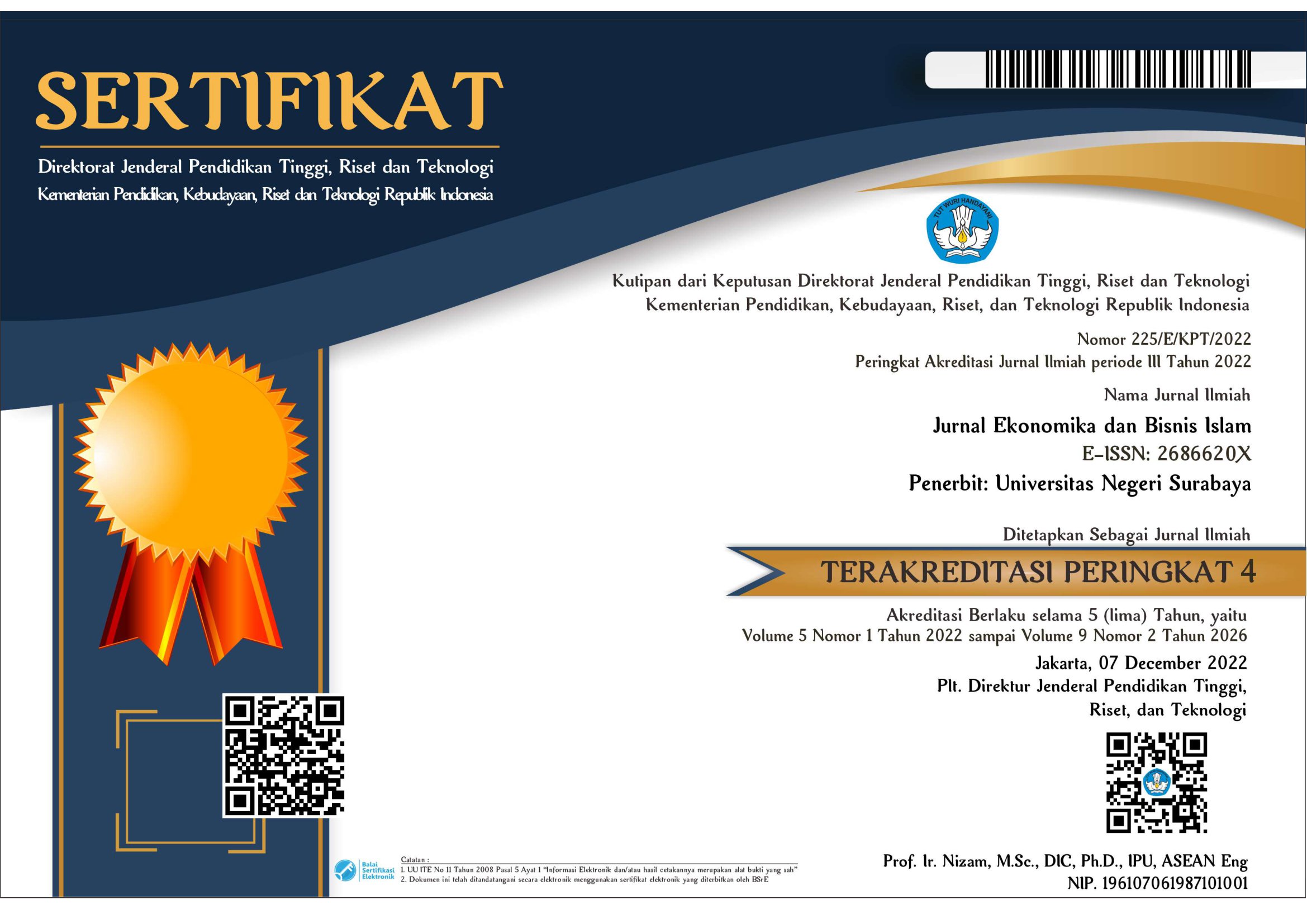Persepsi Masyarakat dalam Kebijakan Merger Bank Syariah Indonesia Studi Kasus Kabupaten
DOI:
https://doi.org/10.26740/jekobi.v5n2.p207-216Keywords:
Perception, Potential, Preference, Religiosity, Merger, and Indonesian Sharia BankAbstract
A low share of the Islamic banking market of 6.01% has led the government to take the initiative to conduct a Syariah bank merger to increase the growth and development of Indonesian Islamic banking as well as drive perceptions in the public that can encourage potential advancement in banking sharia in Indonesia that has not been achieved. This study aims to analyze the perceptions of the people in Tegal Regency towards the BSI merger from the aspects of potential, preference, and religiosity. This research used a type of descriptive quantitative research with an explanatory research approach. The population in this study was all people in Tegal Regency. The sampling technique was carried out using the convenience sampling technique through primary data from as many as 100 respondents. Methods of data analysis using multiple linear regression analysis. The t-test results showed that the potential variable partially had no significant effect on perceptions in the BSI merger, while preference and religiosity partially had a significant effect on public perceptions. The results of the F test show that potential, preference, and religiosity simultaneously influence people's perceptions. From the results of the study, it can be concluded that the hypothesis is accepted.
References
Andrianto, Fatihudin, D., & Firmansyah, A. (2019). Manajemen Bank. CV. Penerbit Qiara Media.
Andrianto, & Firmansyah, M. A. (2019). Manajemen Bank Syariah ( Implementasi Teori dan Praktek ). In Riba dan Bunga Bank (Pertama). CV. Penerbit Qiara Media.
Cooper, D. R., & Schindler, P. S. (2014). Business Research Methods (12th ed.). McGraw-Hill/Irwin.
Gaughan, P. A. (2018). Mergers, Acquisitions, and Corporate Restructurings (7th ed.). John Wiley & Sons, Inc.
Gitman, L. J., & Zutter, C. J. (2012). Principles of Managerial Finance (13th ed.). Pearson. https://doi.org/10.2307/2977800
Harahap, S. S., Wiroso, & Yusuf, M. (2010). Akuntansi Perbankan Syariah (4th ed.). LPFE Usakti.
Hasbullah, H., & Amir, A. (2016). Preferensi nasabah terhadap bank syariah (studi pada nasabah BRI Syariah di Kecamatan Sungai Bahar Kabupaten Muaro Jambi). Jurnal Paradigma Ekonomika, 11(1). https://doi.org/https://doi.org/10.22437/paradigma.v11i1.4112
Ibtimes.id. (2020). Data Populasi Penduduk Muslim 2020: Indonesia Terbesar di Dunia. Ibtimes.Id. https://ibtimes.id/data-populasi-penduduk-muslim-2020-indonesia-terbesar-di-dunia/
KNKS. (2020). Trend Konversi Ke Bank Syariah: Tingkatkan Efisiensi dan Produktivitas Bisnis (Issue 8). https://knks.go.id/storage/upload/1580002526-KNKS Insight Edisi 8 (Januari)-1.pdf
Manggu, S. A. R., & Dalif. (2018). Analisis Persepsi Masyarakat terhadap Bank Syariah di Kabupaten Polewali Mandar Sulawesi Barat. OSF Preprints, 6(9). https://doi.org/10.31219/osf.io/w6gt9
Nurhasanah, S. (2017a). Praktikum Statistika 1 Untuk Ekonomi dan Bisnis (3rd ed.). Salemba 4.
Nurhasanah, S. (2017b). Praktikum Statistika 2 Untuk Ekonomi dan Bisnis (2nd ed.). Salemba 4.
Nurohman, Y. A., & Qurniawati, R. S. (2021). Persepsi Nasabah Generasi Z Pasca Pengumuman Merger Bank Syariah. Jurnal Among Makarti, 14(2).
OJK. (2020). Statistik Perbankan Syariah. In www.ojk.go.id. https://www.ojk.go.id/id/kanal/syariah/data-dan-statistik/statistik-perbankan-syariah/Documents/Pages/Statistik-Perbankan-Syariah---November-2020/SPS November 2020.pdf
Pignataro, P. (2015). Mergers, Acquisitions, Divestitures, and Other Restructurings. John Wiley & Sons, Inc.
Purba, A. A. (2021). Pengaruh Merger Bank Syariah BUMN Terhadap Minat Menabung di Bank Syariah Indonesia Pada Masyarakat Tanjung Balai. Human Falah, 8(2).
Sinulingga, S. (2013). Metode Penelitian (3rd ed.). USU Press.
Sitorus, R. (2021). Resmi! Merger Bank Syariah BUMN Kantongi Izin dari OJK. Finansial.Bisnis.Com. https://finansial.bisnis.com/read/20210127/90/1348702/resmi-merger-bank-syariah-bumn-kantongi-izin-dari-ojk
Wareza, M. (2021). Erick Thohir Bocorkan Alasan Ngotot Merger 3 Bank Syariah. Www.Cnbcindonesia.Com. https://www.cnbcindonesia.com/market/20210122162510-17-218100/erick-thohir-bocorkan-alasan-ngotot-merger-3-bank-syariah
Yuniarti, V. S. (2015). Perilaku Konsumen Teori Dan Praktik (1st ed.). Pusaka Setia.
Downloads
Published
How to Cite
Issue
Section
License
Copyright (c) 2022 Jurnal Ekonomika dan Bisnis Islam

This work is licensed under a Creative Commons Attribution 4.0 International License.
This work is licensed under a Creative Commons Attribution 4.0 International License.
 Abstract views: 1070
,
Abstract views: 1070
, PDF Downloads: 805
PDF Downloads: 805














